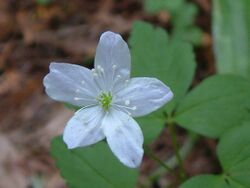Biology:Anemone quinquefolia
| Anemone quinquefolia | |
|---|---|

| |
| Scientific classification | |
| Kingdom: | Plantae |
| Clade: | Tracheophytes |
| Clade: | Angiosperms |
| Clade: | Eudicots |
| Order: | Ranunculales |
| Family: | Ranunculaceae |
| Genus: | Anemone |
| Species: | A. quinquefolia
|
| Binomial name | |
| Anemone quinquefolia | |
| Synonyms | |
|
See text | |
Anemone quinquefolia is a spring-flowering plant in the genus Anemone, native to North America.[2] It is commonly called wood anemone, like Anemone nemorosa, a closely related European species. The American species has been treated as a subspecies of Anemone nemorosa.
Description
It is a perennial herbaceous plant, growing in early spring to 5–30 cm (2–12 in) tall,[3] and dying back down to the root-like rhizomes by mid summer. The rhizomes spread just below the soil surface and grow quickly, contributing to its rapid spread in woodland conditions, where it can carpet large areas. The flower has five (occasionally four, or six to nine) petal-like segments (actually sepals)[4] that are 6–25 mm (0.24–0.98 in) long and 4–8 mm (0.16–0.31 in) wide.[3] The flowers are usually white, but sometimes pink, or with a pink base and white tip, or with a white base and a pink or blue tip.[3][2]
The leaves are in three parts with deeply lobed lateral leaflets, giving the appearance of five leaflets. The leaf veins are branched and not parallel.
Taxonomy
Anemone quinquefolia was named in 1753 by Carl Linnaeus in Species Plantarum. He described it as having leaves with five oval serrated parts;[5] hence the species epithet quinquefolia, meaning "five-leaved".
Anemone quinquefolia is part of a species complex that includes A. grayi, A. lancifolia, A. lyallii, A. oregana and A. piperi.[3]
Varieties
The Flora of North America and The Plant List accept only two varieties:[3][1]
- Anemone quinquefolia var. quinquefolia (DC.) Frodin – grows over the entire species range
- Anemone quinquefolia var. minima – grows in North Carolina, Tennessee and Virginia
The two are distinguished mainly by the size of the achene (the fruit), the body of which is 2.5–3 mm (0.10–0.12 in) in var. minima as compared to 3–4.5 mm (0.12–0.18 in) in var. quinquefolia.
Other sources accept further varieties, such as A. quinquefolia var. bifolia.[6]
Synonyms
Anemone quinquefolia has a number of synonyms. These include:[1]
- Anemone pedata Raf.
- Anemonanthea quinquefolia (L.) Nieuwl.
- Anemonoides quinquefolia (L.) Holub
It has also been treated as part of Anemone nemorosa under the names:[1]
- Anemone nemorosa
- A. n. subsp. americana Ulbr.
- A. n. var. bifolia (Farw.) B.Boivin
- A. n. f. glabriuscula G.Lawson
- A. n. f. nitida G.Lawson
- A. n. f. quinquefolia (L.) G.Lawson
- A. n. var. quinquefolia (L.) Pursh
- A. n. var. quinquefolia (L.) Ulbr.
- A. n. f. trifoliata Ulbr.
References
- ↑ 1.0 1.1 1.2 1.3 "Anemone quinquefolia". The Plant List. Royal Botanic Gardens (Kew). http://www.theplantlist.org/tpl1.1/search?q=Anemone+quinquefolia. Retrieved 2014-05-28.
- ↑ 2.0 2.1 Template:Connecticut Plants
- ↑ 3.0 3.1 3.2 3.3 3.4 Dutton, Bryan E.; Keener, Carl S.; Ford, Bruce A. (1997), "Anemone quinquefolia", in Flora of North America Editorial Committee, Flora of North America North of Mexico (FNA), 3, New York and Oxford, http://www.efloras.org/florataxon.aspx?flora_id=1&taxon_id=233500082, retrieved 2014-05-28
- ↑ Chayka, Katy; Dziuk, Peter (2016), Anemone quinquefolia (Wood Anemone) Minnesota Wildflowers, https://www.minnesotawildflowers.info/flower/wood-anemone
- ↑ Linnaeus, Carolus (1753). Species Plantarum. 1. p. 541. "foliis quinatis ovalibus serratis"
- ↑ "Anemone quinquefolia". Natural Resources Conservation Service PLANTS Database. USDA. https://plants.usda.gov/core/profile?symbol=ANQU.
Wikidata ☰ Q55813565 entry


